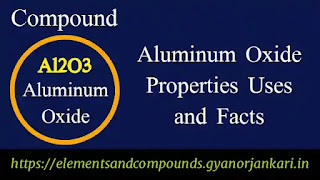Properties Uses and Facts about Aluminum Oxide
What is Aluminum Oxide
Aluminum oxide is a chemical compound composed of aluminum and oxygen with
the chemical formula Al2O3. Its molecule contains two atoms of aluminum and
three atoms of oxygen. In common parlance, it is called alumina, and
depending on the specific uses, it is also called aloxide, aloxite or
alandum. Aluminum oxide is found naturally in the form of corundum, ruby,
sapphire and emerald. It is an amphoteric substance, which reacts with both
acids and bases. It occurs as a solid and usually appears white in
colour.

|
| Aluminum Oxide Al2O3 Properties Uses and Facts |
Properties of Aluminum Oxide
- Aluminum oxide is a white colored crystalline solid.
- It is an odorless substance.
- Its density is 3.95 grams per cubic centimeter.
- Aluminum oxide is found in the solid state at room temperature, its melting point is 2072 °C and its boiling point is 2977 °C.
- It is insoluble in water.
- It does not conduct electricity, that is, it is an electrical insulator.
- In the open environment, a layer of oxide is formed on pure aluminum metal, which is called aluminum oxide, this layer forms a protective layer on aluminum, which prevents aluminum from being further oxidized and provides protection from the environment.
- According to the different methods of preparing aluminum oxide, its physical and chemical properties can vary, such as aluminum oxide made at very high temperatures is chemically inert.
- It reacts with sodium hydroxide to form sodium aluminate and water, a reaction that takes place at a temperature of 900 to 1100 °C.
- Aluminum oxide is an extremely hard substance, with a hardness of 9 on the Mohs scale. The only natural materials harder than this are moissanite and diamond, which have a hardness of 9.5 and 10, respectively, on the Mohs Scale.
Uses of Aluminum Oxide
- Most aluminum oxide is used to make pure aluminum metal.
- Due to its high hardness and high melting point, it is used as an abrasive.
- Aluminum oxide is an inert material within our bodies, and it is a strong and extremely rigid material, which is why it is used in the medical industry for bearings in hip replacements.
- It is also used as a catalyst.
- Aluminum oxide is a light, strong and hard material, so it is used to make bullet proof armor and armor for military vehicles and aircraft.
- It is an electrical insulator, and has a high melting point, so it is used as an insulator in the spark plug and microchip industry.
- Precious stones such as ruby, emerald and sapphire are crystalline forms of aluminum oxide called corundum, which are used to make jewelry.
- Aluminum oxide is one of the common ingredients in sunscreen, besides it is also used in making cosmetics like nail polish, blush and lipstick.
- It is used to make glass, aluminosilicate glass is a commonly used glass which contains about 5% to 10% alumina.
- Aluminum oxide is widely used for the separation of water from gas streams.
Production of Aluminum Oxide
Aluminum oxide is often manufactured by the Bayer process, which means
refining bauxite to produce alumina. The process begins by drying crushed
and washed bauxite, which typically contains 30–55% aluminum oxide. The
slurry is made by dissolving bauxite in caustic soda, which is heated to a
temperature of about 230–520 °F (110–270 °C). This mixture is then filtered
to remove residues called "red mud" impurities. The filtered alumina
solution (aluminum hydroxide) is then transferred or pumped to a
precipitator tank where it cools and seed formation begins. These seeds
stimulate the precipitation process allowing solid aluminum hydroxide
crystals to form. All aluminum hydroxide that settles at the bottom of the
tank is removed. The residual caustic soda is washed from aluminum
hydroxide, which undergoes filtration at various stages. Finally, it is
heated to completely remove the excess water. After passing through the
cooling stage, a fine white powder is produced, which is the pure form of
aluminum oxide.
Detailed Information on Some other Compounds
- Zinc Nitrate Properties Uses and other Details
- Aluminium Nitride Properties Uses and other Details
- Hydroiodic acid Properties Uses and other Details
- Dinitrogen Pentoxide Properties Uses and other Details
- Iodic Acid HIO3 Properties Uses and other Details
- Phosphine (PH3) Properties Uses and other information
- Ethanol Properties Uses and Other Details
- Potassium Cyanide | Properties | Uses | Other Details
- Sodium Hydroxide | Properties | Uses | Facts
- Methane Gas | Properties | Uses | Facts
- Ammonia | Properties | Uses | and Facts
- Sulfuric Acid H2SO4 | Properties | Uses | and Facts
- Nitric Acid HNO3 | Properties | Uses | and Facts
- Hydrochloric Acid HCL | Properties | Uses | and Facts
- Potassium Nitrate KNO3 | Properties | Uses | and Facts
- Hydrogen Peroxide H2O2 | Properties | Uses | and Facts
- Sodium Bicarbonate NaHCO3 | Properties | Uses | and Facts






No comments:
Post a Comment